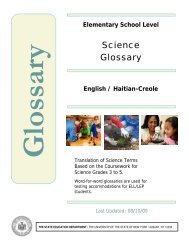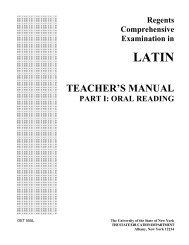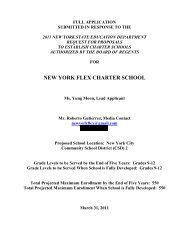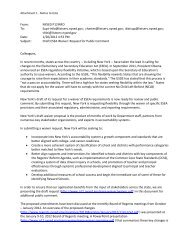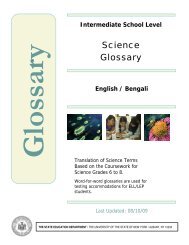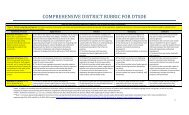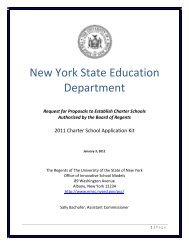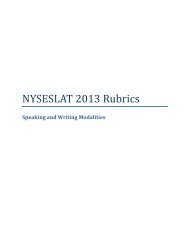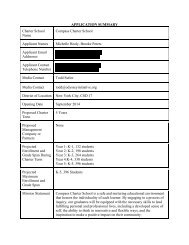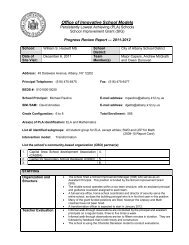PROSPECTUS – Wisteria Charter School - p-12
PROSPECTUS – Wisteria Charter School - p-12
PROSPECTUS – Wisteria Charter School - p-12
You also want an ePaper? Increase the reach of your titles
YUMPU automatically turns print PDFs into web optimized ePapers that Google loves.
<strong>PROSPECTUS</strong> <strong>–</strong> WISTERIA CHARTER SCHOOL<br />
I. EXECUTIVE SUMMARY<br />
<strong>Wisteria</strong> <strong>Charter</strong> <strong>School</strong> (WCS) of Buffalo, New York, is committed to providing an innovative public<br />
educational opportunity to meet the diverse needs of its students. Located in the Nation’s third poorest<br />
city, the school design reflects adherence to the New York State Common Core Standards, through<br />
careful amalgamation of a Waldorf educational approach. This educational framework employs an artsintegrated,<br />
developmentally‐appropriate curriculum which addresses the full spectrum of a child’s<br />
academic and social needs in ways that are meaningful, responsive and inclusive.<br />
Mission Statement<br />
<strong>Wisteria</strong> <strong>Charter</strong> <strong>School</strong> cultivates socially conscious, critical thinkers by addressing students’<br />
intellectual, emotional and physical needs. Utilizing an arts‐integrated Waldorf‐Methods approach,<br />
students are fully prepared to meet the challenges of a multicultural and ever‐changing society.<br />
Meaningful‐ knowledgeable, sound decision‐making<br />
Responsive‐ timely, mindful, purposeful action<br />
Inclusive‐ Expansive, in‐depth, universal<br />
Key Design Elements:<br />
<strong>Wisteria</strong> <strong>Charter</strong> <strong>School</strong> provides a comprehensive program of activities, aimed at creating a community<br />
of compassionate, self‐motivated and intellectually engaged students. <strong>Wisteria</strong>’s curriculum places<br />
equal emphasis on a strong academic foundation, artistic expression, social development, and attention<br />
to the needs of each child. According to William Butler Yeats, “Education is not the filling of a pail, but<br />
the lighting of a fire.” Waldorf education engages a child’s intellect, imagination, will and sense of<br />
aesthetics. How a subject is taught is equally important as what is taught, hence the use of movement<br />
and arts in the curriculum. The research‐based, time‐tested pedagogical methods designed by Dr. Rudolf<br />
Steiner are at the heart of this mode of education. Waldorf methods inspire student volition, inquisition<br />
and creativity because classroom activities involve three key areas—the head (thinking), the heart<br />
(feeling) and the hands (willing).<br />
In the context of a nurturing environment, students will benefit from 1) small instructor‐student ratios,<br />
2) 3 to 4 week‐long instructional content blocks, spanning 2‐3 hours in length, 3) a practical and<br />
consistent 5‐day school week, 4) routinely‐scheduled ELA and Mathematics enrichment periods, 5) 180‐<br />
day school calendar, aligned with the Buffalo City school district for ease in collaboration, 6) Early<br />
Foreign Language Instruction, 7) Comprehensive Art Instruction (visual, theater, vocal, instrumental), 8)<br />
Committed Parental Involvement, and 8) a developmentally‐appropriate curriculum.<br />
Unique Design Characteristics: Academic Rigor, Artistic Relevance, Affirmed Relationship<br />
Art‐Integrated Interdisciplinary Instruction: Arts integration is a key aspect of <strong>Wisteria</strong> <strong>Charter</strong> <strong>School</strong>’s<br />
class instruction because it addresses the multimodalities of individual student educational needs,<br />
learning styles and interests. Content is presented in conjunction with narration, movement, song and<br />
exemplary illustration to address diverse learners. A study conducted by Dr. Carrie Norlund found<br />
students who were educated with Waldorf‐based arts integration reported numerous benefits, including<br />
divergent thinking, internalized knowledge through on‐going visual stimuli, emotional intelligence,<br />
balance self‐perception, creativity and strength of will. 1<br />
1 Norlund, Carrie, Art experiences in Waldorf education: graduates' meaning making reflections, February 28, 2007<br />
Available‐https://mospace.umsystem.edu/xmlui/handle/10355/4457<br />
2
Nature‐Based Experiential Learning: According to Piaget, learning is a continual process of interaction<br />
between the individual and his/ her environment. 2 When applied in an educational setting, students are<br />
afforded the opportunity to engage in concrete physical experiences and actively hypothesize—making<br />
learning both meaningful and memorable constructs. Teachers serve as facilitators of the learning<br />
process, guiding students via experiences, rather than didactic lessons. As a result, children are met in<br />
ways that inspire them to think critically about the connectedness of content‐area subjects.<br />
Differentiation: At <strong>Wisteria</strong>, throughout instructional time, students are encouraged to develop their<br />
understanding of core content through creative and artistic assignments. Subject matter is delivered by<br />
the teacher, who initially sets the instructional tone and degree of difficulty, without the typical reliance<br />
on textbook material. Core content Main Lesson Blocks serve as a tool through which students become<br />
fully engaged in their personal academic process, and work at their own pace. Through mediated<br />
scaffolding, teacher observation, student‐initiated inquiry, peer‐reinforcement and guided practice,<br />
students effectively grasp core content at the most appropriate cognitive level, and generate quality<br />
academic product throughout classroom instruction.<br />
Looping: In this set up, students and teachers are afforded the opportunity to remain together as a<br />
cohesive educational unit for up to three consecutive years. Looping optimizes consistency by increasing<br />
annual instructional time. English language learners, students with disabilities and minority groups show<br />
improved academic performance, more positive peer relationships, and increased self‐efficacy. With<br />
looping, parents are afforded more time to acquaint themselves with teachers, which will strengthen<br />
the bonds of school community.<br />
The Founding Group of WCS<br />
<strong>Wisteria</strong> <strong>Charter</strong> <strong>School</strong>'s founding Board of Directors is a skilled 7‐member consortium of civic leaders,<br />
committed to overseeing the charter school operation. To uphold this commitment, a grant writer, an<br />
attorney, an educator, a member of the philanthropic community, an arts professional, and a financial<br />
professional operate under a clear set of guiding principles dictated by the school's Mission Statement.<br />
Also, one board seat is reserved for the WCS Parent Circle Chairperson, the school's designated liaison.<br />
The Board's ability to effectively launch, oversee and govern the institution is made possible because of<br />
the group's unwavering commitment to the children, families and community for whom it is founded.<br />
The expectations and responsibilities of Board members is not only outlined in the Official WCS Board of<br />
Director's Packet, but it is also enforced as each Board member must sign documentation<br />
acknowledging their fiduciary responsibilities and duties of loyalty to the mission of the school.<br />
Moreover, members of the Board reflect an elite level of experience and education in their respective<br />
fields.<br />
However, the establishment of WCS comes from the active work of the Application Development<br />
Committee. This group consists of a Lead Applicant (who is a tenured NYS Certified Teacher), a grant<br />
writer, an urban planner, an attorney and a broad spectrum of professionals and educators who have<br />
assisted in the preparation of the school's prospectus and application. Furthermore the success of our<br />
program is solidified by our community based relationships with Journey's End Refugee Resettlement<br />
Program, Community Action Organization of Erie County/ Head Start and the Western New York Book<br />
Arts Center. Executive Director Nathan Hare, Executive Director Molly Short and Print Director Chris<br />
Fritton provided WCS with a spectrum of financial, programmatic and child‐centered resources.<br />
2 Kolb, D.A., “Experiential learning: experience as the source of learning and development,” Englewood Cliffs, NJ:<br />
Prentice Hall, 1984.<br />
3
II. STUDENT POPULATION<br />
A. Student Enrollment<br />
Projected Enrollment Table<br />
Grades 20<strong>12</strong>-2013 2013-2014 2014-2015 2015-2016 2017-2018<br />
K 25 25 25 25 25<br />
1 st 25 25 25 25 25<br />
2 nd 25 25 25 25 25<br />
3 rd 25 25 25 25 25<br />
4 th 25 25 25 25 25<br />
5 th 25 25 25 25<br />
6 th 25 25 25<br />
7 th 25 25<br />
8 th 25<br />
Totals <strong>12</strong>5 150 175 200 225<br />
B. Target Populations<br />
Demographic Snapshot‐‐ The City of Buffalo<br />
Buffalo Public <strong>School</strong>s, situated within an urban and demographically diverse Buffalo City<br />
<strong>School</strong> District, serves a vast majority of the municipality's enrolled youth on nearly 70<br />
campuses. 3 Census information continues to indicate that there is a need for new instructional<br />
methods that can appropriately serve a changing student population citywide.<br />
The City of Buffalo has a substantial number of households with school‐age children. According<br />
to 2000 U.S. Census data the City of Buffalo, whose total population was recorded as 292,648<br />
persons, has 39,393 households with children. Of the households with children, 53% (or<br />
20,768) have children between the ages of 0‐4, while 58% (or 22,773) have children 5‐9 years<br />
old and 54% (or 21,466) are 10‐14 years of age. Just as significant is the ethnic diversity in<br />
Buffalo where 54% of the total population is White, 37.2% is Black and 7.5% classify as Hispanic.<br />
Furthermore, 2.5% identify themselves as being a member of 2 or more races while 1.4% are<br />
Asian and .8% are American Indian/ Alaska Native.<br />
<strong>Wisteria</strong> <strong>Charter</strong> <strong>School</strong>‐‐ Welcoming Students with Disabilities, English Language Learners<br />
(ELL) and the Economically Disadvantaged<br />
While statistics paint a picture of diversity, they also tell a story of a city whose populace<br />
struggles financially. In 1999, it was reported that the median household income in Buffalo was<br />
$24,536 and the number of people living below the poverty line was 26.6%. 4 State data<br />
indicates that the total population of students enrolled in K‐<strong>12</strong> in the District is 32,732 and of<br />
3 Accessed via the web on January 3, 2011 Buffalo Public <strong>School</strong>s websitehttp://www.buffaloschools.org/district.cfm?subpage=68<br />
4 Accessed via the web on January 3, 2011 National Relocation Websitehttp://profiles.nationalrelocation.com/New%20York/Buffalo/)(http://quickfacts.census.gov/qfd/states/36/361100<br />
0.html<br />
4
these students, 8.4% are classified as English Language Learners/ Limited English Proficiency.<br />
Posing an even greater challenge to the district are the number of children who are eligible for<br />
free and reduced priced lunches and those who received a Special Education classification<br />
(81.6% and 17.2% respectively) 5 .<br />
In addition to the hard stats and raw data, the City's neighborhood planning reports provide<br />
evidence of the municipality’s development priorities. Currently, the City's Office of Strategic<br />
Planning has determined that "land banking" is the best method to manage the large tracts of<br />
vacant land created by the movement of population from the far Eastside and sections of South<br />
Buffalo to the near Eastside, North Buffalo and parts of the Westside. This is significant since<br />
decisions made regarding the physical environment, including residential housing and<br />
neighborhood development, are directly related to where new immigrants settle in the city.<br />
Therefore the development strategies employed by our municipality are an indicator as to<br />
where the school will be located and how we will reach a large segment of our target<br />
population who continue to settle here from all over of the globe.<br />
In an effort to accommodate the educational needs of our target population, <strong>Wisteria</strong> <strong>Charter</strong><br />
<strong>School</strong>’s physical presence as well as its use of Waldorf methods is especially beneficial. For<br />
those who lack fluency in English, live in conditions of poverty, and those with special<br />
educational needs, quality education is a necessity for prosperity. With the assistance of our<br />
network of related agencies and their corresponding programs, WCS is well suited to serve<br />
neighborhoods with increasing numbers of newly resettled school‐aged children in a nurturing<br />
environment with conscious, intentional, and planned diversification. Waldorf methods make<br />
progressive education possible for communities that face the challenges of poverty and cultural<br />
assimilation.<br />
Plan for Recruitment and Enrollment‐ Meeting the Needs of the District<br />
<strong>Wisteria</strong>'s founders feel that it is important to serve the entire community and to support the<br />
school district by reaching out to populations not traditionally involved in, or knowledgeable<br />
about methods used in Waldorf education. Our plan for recruitment and enrollment will result<br />
in a balanced lottery and a balanced shift in the demographics that comprise the Buffalo Public<br />
<strong>School</strong>s.<br />
The network of professionals that WCS has formed a relationship with includes the Community<br />
Action Organization of Erie County (CAO). The CAO is a $31 million dollar social services agency<br />
with a Head Start program. Head Start's early childhood education program is available to low<br />
income families whose children qualify for free and reduced priced lunches once the child is old<br />
enough to enroll in a District school. In addition to this, we have also developed a relationship<br />
with Journey's End Refugee Resettlement. Journey's End is the only New York State sponsored<br />
immigrant resettlement organization, with an education component, located in the City of<br />
Buffalo.<br />
5 Accessed via the web on January 3, 2011 New York State Department of Education Websitehttp://www.p<strong>12</strong>.nysed.gov/psc/startcharter.html<br />
5
The populations served by CAO and Journey's End mirror the groups of residents needed to<br />
have a healthy and balanced student population. We will be using the tight network of<br />
contacts and communications to further introduce Waldorf's educational principles to the<br />
parents of ELL students and those from low income households. These professional<br />
relationships will form the basis of our long‐range outreach activities and ensure that we will<br />
have strong community linkages solidified by trust.<br />
Educational Choice Options‐ Keeping Everyone Informed<br />
All of the aforementioned factors make the introduction of WCS, a Waldorf methods charter<br />
school, both timely and appropriate. To ensure the success of WCS, the Application<br />
Development Committee has recruited an award‐winning Community Engagement Specialist to<br />
design and facilitate an ongoing process of civic engagement that extends beyond the<br />
application review period. The outreach methods employed by <strong>Wisteria</strong> <strong>Charter</strong> <strong>School</strong><br />
Initiative have already begun and will continue in varying intensities and focus for as long as the<br />
school is in existence. This approach will ensure that the institution mutually addresses the<br />
needs of the communities from which the student body resides.<br />
Phase One of <strong>Wisteria</strong>’s outreach strategy sought citywide input. It involved a full spectrum of<br />
communication techniques that has made <strong>Wisteria</strong> largely popular in neighborhoods<br />
throughout the school district. The first phase was divided into steps. Now that the first phase<br />
is complete and the Prospectus is submitted the second phase begins. Phase Two will continue<br />
to communicate with neighborhoods across the city but will also have a special focus on low<br />
income and immigrant populations to inform parents of the benefits of Waldorf methods and<br />
<strong>Wisteria</strong>'s lottery and enrollment process.<br />
Phase One<br />
• Step 1‐‐ News Paper Articles<br />
There were two articles printed in the Buffalo News on January <strong>12</strong>, 2011 the first was a report<br />
in the <strong>School</strong> Zone Blog section of the online edition and the other was a front page story in the<br />
print edition of the City and Region section.<br />
Buffalo Rising: News Daily featured a story about <strong>Wisteria</strong> on the same day (Jan. <strong>12</strong>th) as the<br />
Buffalo News reports. These articles served to promote WCS and advertise the public meetings<br />
on a broad scale.<br />
• Step 2‐‐ Public Meetings<br />
We've held four large public meetings in the areas that the Committee identified as having<br />
neighborhoods suitable to locate our proposed school. Dispersed in the east, west, north and<br />
central sections of the city, these meetings represented the full diversity of the population of<br />
Buffalo's neighborhoods. To ensure ample attendance the following methods of<br />
communication was used: The Buffalo News, radio, TV news, posters, handbills and websites.<br />
Dates and locations of the initial public presentations: Niagara Branch Library January <strong>12</strong>, 2011,<br />
6
Merriweather Branch Library January 13, 2011, University at Buffalo’s Allen Hall January 14 th ,<br />
2011 and Crane Branch Library January 15 th , 2011.<br />
In addition to the large meetings, several small meetings were held where parents familiar with<br />
Waldorf educational methods met and discussed the possibility of a charter school over<br />
Waldorf‐inspired craft activities. These meetings, known as "Handworks," were by invitation<br />
based on contacts formed at Waldorf programs in Buffalo and East Aurora, New York.<br />
• STEP 3‐‐ Hit the Airways<br />
Radio, Internet, Television: These are relatively quick ways to let the community know that<br />
surveys are available, meetings are planned and that input is sought. The Founding group<br />
conducted radio talk show interviews for “Living Now” on January 17, 2011 and “Kirkland's<br />
Korner,” on January 25, 2011. We have an Official <strong>Wisteria</strong> <strong>Charter</strong> <strong>School</strong> Website and Blog<br />
where we provide information and continuous updates for those interested in following the<br />
development of <strong>Wisteria</strong> <strong>Charter</strong> <strong>School</strong>. We were also on Channel 7 WKBW TV's website<br />
billboard and on YNN (Your News Network) website billboard on January 15th. An abundance<br />
of fast‐breaking news stories prevented the stations from giving us the scheduled coverage that<br />
was previously scheduled.<br />
• STEP 4‐‐ Conduct A Survey<br />
A brief survey instrument was developed and distributed at each of the large meetings and to<br />
those in the smaller gatherings. The survey was also posted on informational blogs, on the<br />
Official <strong>Wisteria</strong> <strong>Charter</strong> <strong>School</strong> Initiative blog and website. The Better <strong>School</strong>s/ Better<br />
Neighborhoods Headquarters on Fillmore Avenue served as the official survey/ comment sheet<br />
drop‐off point for those who lack Internet access. Group Ministries Human Services Center<br />
distributed the surveys to clients enrolled in their programming. In addition to questions<br />
directly related to the proposed school, those completing the questionnaire were also asked for<br />
their zip code. This information was geo‐coded on a map of the city and the responses were<br />
reviewed and analyzed based on where the respondents reside. Comments were also received<br />
online via our website's Contact Us Page in the Comment section as well as by email.<br />
• STEP 5‐‐ Meet with Civic Leaders and Elected Officials<br />
Our Outreach Specialist also set 1:1 meetings and phone conversations with <strong>School</strong> Board<br />
Members, Elected Officials, not for profit executives and the Superintendent of <strong>School</strong>s to get<br />
candid information to identify additional resources and to assist with the overall establishment<br />
and viability of the proposed school.<br />
The Phase Two and all subsequent phases will incorporate the communications mechanisms<br />
used by the non profit social service agencies responsible for assisting populations that we<br />
hope to reach in addition to methods we have already employ. In addition to this, we will also<br />
be arranging meetings with the local philanthropic and banking community to garner additional<br />
financial resources to keep <strong>Wisteria</strong> strong.<br />
7
Waldorf methods embrace community and connectedness therefore, we will always employ<br />
outreach strategies that are meaningful, responsive and inclusive, to address that which is<br />
important to our school community.<br />
SERVING AT‐RISK STUDENTS AND STUDENTS WITH DISABILITIES<br />
Meaningful Needs Framework<br />
<strong>Wisteria</strong> <strong>Charter</strong> <strong>School</strong> is designed to include high level instruction, designed to meet the<br />
needs of a wide range of learners. Our program will involve screening, progress‐monitoring,<br />
qualified instructors (receiving on‐going, practical professional development), along with<br />
timely, appropriate and effective intervention. Embedded in the curriculum are numerous<br />
means to address diversity in learning and the challenges associated with that diversity. On all<br />
levels, from administration to teachers to students and parents, <strong>Wisteria</strong> ensures open dialogue<br />
pertaining to student performance involving acknowledgement of cultural and linguistic needs,<br />
and the guarantee of appropriate instruction.<br />
Responsive Needs Framework<br />
Should a student fall below appropriate grade level benchmarks, a school‐wide progressmonitoring<br />
system will be enacted for a period of weeks, during which parents or caregivers will<br />
be notified. Data collected from a range of formative and interim assessments from teachers<br />
will be reviewed.<br />
Differentiated instruction to suit individual challenges will provide immediate feedback, as<br />
student progress is monitored. If a deficit is determined, a 3‐Tiered Response to Intervention<br />
model will be initiated to 1) determine the needs of the student and 2) aid in determining<br />
whether additional assistance is required. (Illinois PBIS May 15,2008, Adapted from “What is<br />
PBS?”, http://pbis.org/schoolwide.htm) Both academic and behavioral interventions will be<br />
blended seamlessly within the school’s classroom instructional design.<br />
If a student is deemed “at risk,” WCS teacher will discuss options with the Instructional<br />
Coordinator and plan for increased academic intervention. At or prior to that time, parents or<br />
caregivers will be notified to develop and implement smaller‐group instruction and increased<br />
individualized classroom activity monitoring, which may be provided by additional classroom<br />
co‐teachers or paraprofessionals. In keeping with the responsive needs framework, all students<br />
at <strong>Wisteria</strong> <strong>Charter</strong> <strong>School</strong> will have individualized folders. Here, work may be added, or<br />
assignments may be differentiated in a discrete manner. Folders will be marked accordingly for<br />
any students identified as “at‐risk.” If more assistance is required in order for students to meet<br />
or exceed academic proficiency, high‐impact intervention strategies will be employed. Coupled<br />
with frequent assessment of progress, data collected during the 3‐Tiered RTI method will assist<br />
parents and caregivers, as well as the school in making recommendations to the District’s<br />
Committee for Special Education. In conjunction with <strong>Wisteria</strong> <strong>Charter</strong> <strong>School</strong>’s Special Ed.<br />
Coordinator, CSE will conduct a comprehensive multidisciplinary evaluation and prepare a<br />
written report of student performance levels. If deemed necessary, an Individualized Education<br />
Program (IEP) will be developed in keeping with the determined disability.<br />
8
Inclusive Needs Framework<br />
Services will be rendered with the needs of each particular student in mind. The IEP will guide<br />
instruction for that student, indicating any classroom, instructional or assignment‐related<br />
modifications. To ensure academic and social success for all students, WCS is committed to<br />
education if students with disabilities in the least restrictive environment. Accommodations will<br />
be offered discreetly and consistently to complement the normal classroom rhythms. Should a<br />
student enroll at <strong>Wisteria</strong> and has previously been identified as needing an IEP, WCS will<br />
conduct IEP reviews, to assure that the student is benefitting from a free and appropriate public<br />
education. Depending on the student and required level of service, some of the various<br />
educational arrangements we have budgeted for are:<br />
Organizational Level Resources or Tools Function<br />
Administrative<br />
Special Education Coordinator<br />
Appointed to teach students<br />
directly, arrange and conduct<br />
annual IEP reviews, hold<br />
meetings, and confer with<br />
parents<br />
Faculty (teacher) Integrated Co‐Teaching Model at<br />
the classroom level<br />
Designed to unobtrusively serve<br />
a variety of students<br />
Faculty (All Levels)<br />
Meaningful and Practical<br />
Professional Development<br />
Geared toward maintaining an<br />
exceptional Special Education<br />
setting<br />
Student(s)<br />
Parents, Faculty, <strong>School</strong><br />
Community<br />
“Lattice” Support and<br />
Enrichment Room<br />
Active collection of reading<br />
material and instructional<br />
resources<br />
To provide individual or smallgroup<br />
enrichment of daily<br />
lessons<br />
Parents, teachers and<br />
administrators have useful<br />
information at their disposal<br />
SERVING ENGLISH LANGUAGE LEARNERS/ STUDENTS WITH LIMITED ENGLISH PROFICIENCY<br />
Meaningful Service Framework<br />
<strong>Wisteria</strong> <strong>Charter</strong> <strong>School</strong> is set to welcome all students and families, regardless of need. The<br />
educational framework is poised to address a wide range of socioeconomic, cultural, and<br />
intellectual criteria. In recent years, Buffalo has experienced an influx of Students with<br />
Interrupted Formal Education (SIFE). Because of the Spanish‐speaking population and many<br />
new SIFE children, <strong>Wisteria</strong> is poised to form a long‐standing relationship with the English<br />
Language Learner population.<br />
In compliance with New York State and Federal laws, all potential students at <strong>Wisteria</strong> <strong>Charter</strong><br />
<strong>School</strong> will begin the English Language Learner screening process with the Home Language<br />
Questionnaire. If the student’s home language is a language other than English, <strong>Wisteria</strong> will<br />
utilize its ongoing collaborative effort with Journey’s End Refugee Resettlement (a member of<br />
our agency network) to conduct interviews in the student’s native language as well as English.<br />
Journey’s End will supply translation in school or at the home of the student. Academic<br />
coaches, fluent in <strong>12</strong> languages are available to “push in” to classrooms and assist hands‐on.<br />
9
These coaches provide teaching tools to support the educational growth process. Students who<br />
are English Language Learners or students with Limited English Proficiency, once determined,<br />
must take the Language Assessment Battery‐ Revised (LAB‐R), determining their need for ESL<br />
services.<br />
Responsive Service Framework<br />
<strong>Wisteria</strong> <strong>Charter</strong> <strong>School</strong> will take full advantage of longer routine scheduling blocks to meet the<br />
needs of English Language Learners. ESL lessons will be administered by a New York State<br />
certified ESL teacher who is acclimated to Waldorf teaching methods. In a two‐year research<br />
study conducted at the University of New Hampshire, struggling English Language learners were<br />
more prolific when provided with simple art supplies to supplement standard “pen and paper”<br />
writing exercises. Assessment of student work illustrated more organized, imaginative<br />
narratives, rich in content, even from emerging young writers. 6<br />
Because of the teacher’s knowledge of interdisciplinary instruction, students are encouraged<br />
engage in course curricula with zest, joy and love of learning. When teachers utilize movement,<br />
students retain vocabulary, acquire more content knowledge, and demonstrate increased<br />
comprehension skills. In addition, cultural connectedness through artistic expression maximizes<br />
student self‐efficacy 7<br />
Students feel encouraged and affirmed at school, rather than being viewed as outsiders.<br />
<strong>Wisteria</strong> <strong>Charter</strong> <strong>School</strong>’s afternoon skills blocks will serve as ESL instructional time. Students<br />
eligible for bilingual services will take the New York State English as a Second Language<br />
Achievement Test (NYSESLAT) annually, to determine future ESL course content needs.<br />
Translators from Journey’s End will be utilized on an “as‐needed” basis, to meet the Native<br />
Language Arts (NLA) requirements. In addition to the NYSESLAT, student receiving ESL services<br />
will be subject to quarterly language skills portfolio assessments, using appropriate ELL<br />
language acquisition, including criterion‐referenced evaluation.<br />
Professional development opportunities may be provided “in‐house” by staff members, or<br />
facilitated by Journey’s End Refugee Resettlement. On‐going faculty learning opportunities will<br />
be instituted to address <strong>Wisteria</strong>’s faculty and staff members, and familiarize them with the<br />
necessary policies, procedures and challenges associated with attracting, retaining, and<br />
meeting the academic and social needs of LEP students.<br />
“Parent Circle”<br />
We believe that parental involvement is crucial to the successful implementation of schoolwide<br />
accountability. Parents are a vital part of the school community, and are valued for their<br />
support of student achievement within the classroom as well as at home. <strong>Wisteria</strong> <strong>Charter</strong><br />
6 Olshansky, Beth. “Picture This: An Arts‐Based Literacy Program,” Educational Leadership, September 1995, Vol.<br />
53, No. 1.<br />
7 Gourgey, Bousseau, & Delgada, Children’s Theater Review, 1985.<br />
10
<strong>School</strong> is committed to actively supporting parents through Parent Circle Chairperson and the<br />
various levels of parental involvement.<br />
Inclusive Service Framework<br />
In the way of retention, the Parent Circle will collaborate with Journey’s End to serve as a<br />
strong support network, promoting the <strong>Wisteria</strong> Clothes Swap, car‐pool system and utilization<br />
of the community room. Teacher‐directed plays and assemblies, seasonal festivals and<br />
fundraisers serve to unify the community‐at‐large in support of these students. The school’s<br />
Faculty Chairperson will serve as liaison between parents, teachers and the administrative<br />
body, communicating needs that may extend beyond the classroom, but still impact the school<br />
wide community. Members of the Administrative Committee will assure that school<br />
communicative materials are translated into various languages. Languages for the communities<br />
we will serve may include, but are not limited to: Arabic, Burmese, Vietnamese, Turkish,<br />
Spanish, French, Swahili, Kinyarwanda, Nepali, Serbian, and Karenni.<br />
Students will benefit from continued differentiated instruction through ESL teachers.<br />
Instruction steeped in real sensory experiences, oral tradition, and repetition to mastery,<br />
combined with world literary approach addresses the needs of LEP students. Looping, which<br />
promotes healthy teacher‐student relationships, has also proven to be beneficial to the English<br />
Language Learner. Because of the nurturing environment offered by <strong>Wisteria</strong> <strong>Charter</strong> <strong>School</strong>,<br />
both teachers, ESL students and their classmates feel more comfortable. Through routine<br />
visual, auditory and kinesthetic stimulation, students are less likely to demonstrate fear and<br />
apprehension in the classroom, which are typical dilemmas for this population. Waldorf<br />
principles encourage active and intentional engagement with the community whereby the<br />
school seamlessly integrates with the neighborhood around it. Therefore, meaningful,<br />
responsive and inclusive public input is of the utmost importance to the founding members of<br />
the <strong>Wisteria</strong> <strong>Charter</strong> <strong>School</strong> and it is our intent and mission to incorporate the needs of our<br />
community into the development of WCS.<br />
III. SCHOOL DESIGN<br />
a. Increase student achievement and decrease student achievement gaps in reading/language<br />
arts and mathematics<br />
There is clearly a need to achieve higher standards, and close many of the achievement gaps<br />
that exist in education today. <strong>Wisteria</strong> <strong>Charter</strong> <strong>School</strong>’s Waldorf‐methods design will provide an<br />
interdisciplinary, art‐integrated approach to learning. Research of these time‐tested features<br />
has illustrated significant gains in elementary school reading fluency and comprehension, ELA<br />
and Mathematics standardized test scores, student achievement and intrinsic motivation. At<br />
the same time, these schools seamlessly support literacy across the curriculum. Students<br />
educated via Waldorf methods in arts‐based Waldorf <strong>School</strong>s scored higher than their peers on<br />
the National SAT. 8 Rather than an accessory at <strong>Wisteria</strong>, the arts serve as the framework for<br />
achievement in English Language Arts, Mathematics, Science and Social Studies.<br />
8 Oppenheimer, “<strong>School</strong>ing the Imagination,” 1999.<br />
11
In The Challenge: Building a Successful 21 st Century <strong>School</strong> District, Deputy Superintendent of<br />
Buffalo Public <strong>School</strong>s, Dr. Folasade Oladele notes that literacy across the curriculum must be<br />
firmly established in pre‐kindergarten through accurate, routine phonemic awareness and the<br />
alphabetic principle. Furthermore, the City of Buffalo plans to address the stages in early<br />
literacy from a developmental perspective, while addressing each individual core content area.<br />
Emphasis is being placed on reading, writing, critical thinking, meta‐cognition and culturally and<br />
linguistically responsive teaching 9 .<br />
Meaningful Achievement Framework<br />
In a Waldorf <strong>–</strong>Methods approach, educators seek to build “capacities” for learning. Instructors<br />
apply developmentally‐appropriate educational practices which lay the foundation for<br />
profound and long‐term academic achievement. Research conducted by Dr. Ida Oberman found<br />
that students educated in urban public Waldorf‐methods schools showed significant gains in<br />
English Language Arts and Mathematics. In two of the three cases studied, public Waldorfmethods<br />
students met or exceeded their comparable counterparts in performance on eightgrade<br />
state assessments. The third school (a large, urban school with a high percentage of Free<br />
and Reduced Lunch and English Language Learners) showed remarkable gains. Student scores<br />
went from 67% “Below Basic” in ELA to 61% “Proficient or Above” by their eight‐grade year.<br />
Thirty‐four percent of the students were “Below Basic” in math. However, by grade eight, 66%<br />
scored “Proficient or Above” on state math assessments. 10<br />
Responsive Achievement Framework<br />
Student will engage in music, visual art, movement and drama throughout the day in<br />
integration. Arts integrated schools in Minneapolis reported substantial effects for all students.<br />
The greatest impact was for disadvantaged students. “Students become better thinkers,<br />
develop higher order skills, and deepen their inclination to learn. 11 In addition, students will<br />
receive enrichment through hands‐on instruction in practical handwork, movement and<br />
physical education, which support intellectual growth. For example, foundational drawing in<br />
response to literature in the early grades gives way to concrete understanding, enhanced<br />
critical thinking and increased variety and complexity of student written and verbal responses<br />
in all subject areas.<br />
While meeting the needs of diverse learners, an arts‐integrated curriculum speaks to the<br />
necessary student behavioral qualities that enrich school classrooms and enhance school<br />
communities. <strong>School</strong> Climate has a direct impact on addressing student achievement gaps.<br />
When students are genuinely engaged in course content, instructional time is maximized, as<br />
students are less likely to engage in disruptive behaviors. The report on “A+ <strong>School</strong>s” cited a<br />
94% drop in school situations requiring school disciplinary action. (A+ <strong>School</strong>s, U of NC‐<br />
9 Oladele, Dr. Folasade, “The Challenge: Building a Successful 21 st Century <strong>School</strong> District,” Buffalo Public <strong>School</strong>s,<br />
2009.<br />
10 Oberman, Dr. Ida, “Learning From Rudolph Steiner: The Relevance of Waldorf Education for Urban Public <strong>School</strong><br />
Reform,” September 2007.<br />
11 Rabkin & Redmond, “The Art of Education,” 2005.<br />
<strong>12</strong>
Greensboro) Increased interest in taking risks, cooperating, solving problems independently<br />
and within groups, preparedness and taking initiative for learning are benefits of such a<br />
program.<br />
At <strong>Wisteria</strong> artistic endeavors are neither fragmented nor isolated. They are incorporated into<br />
each of the academic subjects studied. Students draw, play instruments, paint, sing, use<br />
practical objects and outdoor exploration, act and recite poetry as part of their main lesson and<br />
special subjects. Writing across the disciplines allows for guided and independent practice,<br />
while instilling an ongoing and progressive love of learning. In the arts integrated A+ <strong>School</strong><br />
Program, fourth grade state writing test scores improved 30 percentile points. <strong>12</strong><br />
Inclusive Achievement Framework<br />
The use of the arts integration in an educational setting has been well‐documented as being<br />
beneficial to a wide range of learners with differing learning styles. According to Ingram and<br />
Riedel, 13 significant gains in reading scores of third through fifth graders were noted. In the<br />
study, English Language Learners and students from low socioeconomic backgrounds illustrated<br />
more pronounced benefits. Because the class teacher recites the lessons directly with less<br />
reliance on textbooks, course material is received firsthand, without the excessive use of<br />
handouts, worksheets and workbooks. When overused, these additional “teaching aids” may<br />
hinder a struggling student’s comprehension. Furthermore, <strong>Wisteria</strong>’s use of the arts to teach<br />
English Language learners and multilingual students allows for increased opportunities for<br />
teachers and students to explore issues of diversity through visual art, song and poetic verse.<br />
The Founding group’s ability to assist in closing the achievement gaps is evident through the<br />
careful selection of highly‐qualified teachers, as outlined in NCLB. Teachers utilize curriculum<br />
guides to identify key academic skills, thus maximizing “teacher‐student” direct contact.<br />
b. Increase high school graduation rates and focus on serving at‐risk high school student<br />
populations (including re‐enrolled drop‐outs and those below grade level);<br />
A solid foundation in the elementary grades will lead to academic success in later years. Ina<br />
research study, Waldorf graduates considered their Waldorf education to be “very influential”<br />
in their ability to think critically, challenge assumptions, verbalize, form judgments, and view<br />
things in wider concept. They also reported increased interest in positive social interaction and<br />
increased interest in crafts and practical handwork. There was a decreased interest in passive<br />
forms of education and recreation, like “watching television” 14 There was a direct relationship<br />
observed between the number of years spent in a Waldorf‐methods educational program and<br />
genuine interest in diversity and other cultures. The Waldorf program provides students with<br />
<strong>12</strong> “A+ <strong>School</strong>s,” University of North Carolina at Greensboro<br />
13 Ingram & Riedel, “Arts for Academic Achievement,” 2003.<br />
14 Oberman, Dr. Ida, “Learning From Rudolph Steiner: The Relevance of Waldorf Education for Urban Public <strong>School</strong><br />
Reform,” September 2007.<br />
13
developmentally appropriate, multidisciplinary approaches to learning, resulting in increased<br />
achievement and school success. 15<br />
c. Focus on academic achievement of middle school student populations and preparation for<br />
transition to high school<br />
WCS recognizes the importance of addressing the academic and social challenges that often<br />
face this unique population. The inclusion of practical handwork in Kindergarten and the early<br />
grades (activities like knitting, painting, woodwork, and Suzuki strings) build confidence,<br />
volition, manual dexterity and develop fine and gross motor skills. These tasks are linked to<br />
linguistic ability, grammatical acumen, mathematics and sequencing, and timing ability. In<br />
Educational Leadership, Norman Weinberger, a professor at the University of California at<br />
Irvine, wrote, “Music has the ability to facilitate language acquisition, reading readiness, and<br />
general intellectual development, to foster positive attitudes and to lower truancy in middle<br />
and high school, to enhance creativity, and to promote social development, personality<br />
adjustment, and self worth.” Waldorf methods not only develop certain specific skills; they<br />
actually strengthen synapses in the brain, creating a sense of wholeness in young children.<br />
These students emerge with talents and skills that engage both the creative portion of the brain<br />
and the logical portion. 16<br />
d. Utilize a variety of high‐quality assessments to measure understanding and critical<br />
application of concepts<br />
Meaningful Assessment Framework<br />
<strong>Wisteria</strong> <strong>Charter</strong> <strong>School</strong> will employ a variety of effective assessment measures to ensure high<br />
student performance, achievement, while continuing to build character and self‐motivation.<br />
Student performance will be evaluated primarily through student portfolio assessment. Teacher<br />
observations, weekly progress notation and evaluation of student skills in all content areas via<br />
student in‐class inquiry will continue to drive instruction. <strong>School</strong> faculty planning sessions and<br />
grade level team meetings will be utilized for curriculum mapping. Group professional<br />
development opportunities will be used by all teachers to develop detailed evaluation rubrics<br />
clearly illustrating individual student progression to task mastery. Students with disabilities will<br />
be afforded all necessary accommodations and will be evaluated in accordance with IEPs 17 .<br />
Responsive Assessment Framework<br />
Initial literacy screenings like San Diego Quick (SDQ) will be administered to gauge student<br />
performance levels. Formative assessments will be developed by teachers, under the guidance<br />
and direction of the Curriculum Lead Teacher. Also, adaptations of city and state‐adopted<br />
textbook material will be incorporated. Interim grade‐level benchmark assessments will be<br />
implemented and utilized as an ongoing measure of success within a quarterly academic time<br />
frame. Progress reports will be distributed quarterly, in line with the city school district.<br />
15 Almon, Joan, “Educating for Creative Thinking: The Waldorf Approach,” ReVision, Fall 2003.<br />
16 Petrash, Jack, Understanding Waldorf Education: Teaching from the Inside Out, Gryphon House Books, 2002.<br />
17 Jenkins & Johnson, “Formative and Summative Assessment,” The Gale Group, Accessed January 5, 2011‐<br />
http://www.education.com/reference/article/formative‐and‐summative‐assessment/<br />
14
Inclusive Assessment Framework<br />
Information is shared through parent‐teacher conferences, and allows for an open exchange of<br />
goals, objectives and outcomes. In the way of summative assessment, State‐mandated<br />
standardized tests, portfolios, and teacher‐created narrative progress summaries will illustrate<br />
student achievement. Final student portfolios must demonstrate proficiency, through<br />
achievement benchmarks. Again, carefully crafted rubrics will be utilized. Routine data<br />
collection and analysis using a range of assessments such as Individual Reading Inventory<br />
Assessments, DRA‐2 and CLOZE will provide a well‐rounded pupil evaluation. For students with<br />
Limited English Proficiency, <strong>Wisteria</strong>’s ESL coordinator will cross‐reference language acquisition<br />
with student performance data on the NYSESLAT Test. Faculty planning sessions will be used to<br />
sort and analyze assessment data, allowing for fluid discussion to influence forthcoming<br />
instruction. 18<br />
e. Increase implementation of local instructional improvement systems to assess and inform<br />
instructional practice, decision‐making, and effectiveness<br />
<strong>Wisteria</strong> <strong>Charter</strong> <strong>School</strong> acknowledges that effective schools are those that implement<br />
instructional improvement systems to provide valuable information on student performance,<br />
teacher preparedness, administrative soundness and school policy. Overall success lies in the<br />
even application of these educational criteria. The organizational structure of WCS relies on the<br />
seamless flow of information, interactions between Administration, the Board of Directors,<br />
school faculty, parents and students.<br />
<strong>Wisteria</strong> <strong>Charter</strong> <strong>School</strong><br />
Organizational Chart<br />
Administrative<br />
Committee<br />
Administrator<br />
STUDENTS<br />
STUDENTS<br />
Parent<br />
Circle<br />
Parent<br />
Chair<br />
Board of<br />
Directors<br />
STUDENTS<br />
Faculty<br />
Council<br />
Faculty<br />
Chair<br />
18 Ehringhaus, Michael & Garrison, Catherine, “Formative and Summative Assessments in the Classroom” National<br />
Middle <strong>School</strong> Association, Accessed January 5, 2011 via the webhttp://www.nmsa.org/publications/webexclusive/assessment/tabid/1<strong>12</strong>0/default.aspx<br />
15
On the district level, <strong>Wisteria</strong> will communicate with Western New York BOCES, to allow for<br />
school‐to‐school transparency, and District collaboration. Both teachers and administration will<br />
benefit from centralized data and mutual accountability systems.<br />
Meaningful Administrative Committee<br />
<strong>School</strong>‐wide accountability is upheld by firm, effective and open administration. The selected<br />
school leader is in charge in this endeavor. Contacts with students, teachers and parents are<br />
administer‐initiated, and take day‐to‐day life into consideration. Information‐sharing reflects a<br />
breadth of knowledge and a variety of constructs.<br />
Our Administrative Committee will forge meaningful partnerships by providing the school<br />
community with the security that school‐wide decision‐making is appropriate, fiscally sound<br />
and feasible. A school principal should truly believe in the ability of each faculty member. In<br />
doing so, a community of trust and shared‐responsibility prevails. Many times, at the heart of<br />
school evaluation is value judgment. At <strong>Wisteria</strong>, the notion of evaluation is accompanied by<br />
supportive network of skilled educators, resources, and a framework involving open dialogue,<br />
absent of negative judgment.<br />
In forthcoming administrative recruitment initiatives, we will secure a leader who demonstrates<br />
a comprehensive understanding of the student population of <strong>Wisteria</strong>. Particularly, issues of<br />
diversity will be carefully considered. 19<br />
Responsive Faculty Council<br />
The faculty Council will truly serve a support network for novice as well as veteran teachers.<br />
Rather than numerous invaluable “drive‐by” feedback evaluations, teachers discuss classroom<br />
successes and failures within the context of a team. Teachers certified for certain grade levels<br />
with gather in “loops” to share best practices, suggest practical instructional strategies, and<br />
pool resources. Through centralized district approach, information is both immediate and easily<br />
shared. According to Brenda Smith, president of Douglas County Foundation and AFT Colorado,<br />
“Support and evaluation have to come together in a fluid process that builds trust and<br />
encourages people to talk about where they believe they need to improve.” 20<br />
Assessment data will be gathered and used to guide instruction. In the grades, student main<br />
lesson books become valuable tools illustrating weekly, monthly, and yearly progress. These<br />
content‐rich student‐created portfolios may be shared for teacher‐designed analysis. Such<br />
information sharing in a non‐threatening environment will outline program strengths and<br />
highlight areas for critical evaluation. Student portfolios remain with the teacher from year to<br />
year, and at the end of each looping cycle, portfolios may be presented to new teachers in<br />
advance of the school year for in‐depth academic prior knowledge. Comfort levels increase for<br />
19 Davis, Darling, Laporte, Meyerson, “Leadership Study: Developing Successful Principals” Stanford University<br />
20 “Continuous Improvement: Making Evaluation a Toll for Increasing Teacher—and Student—Learning”, American<br />
Educator, Summer 2010.<br />
16
diverse populations, thus encouraging students to be more outspoken—taking more risks, as<br />
they trust their peers and gain increased confidence in the teacher and the school<br />
community. 21<br />
The <strong>Wisteria</strong> Administrative Committee will meet monthly with the Faculty Chairperson to<br />
develop teacher performance assessment rubrics, which will be completed bi‐annually along<br />
with a formal review process with administration. In‐house professional development sessions<br />
will be utilized to compile and analyze data, and inform decisions.<br />
Inclusive “Parent Circle”<br />
We believe that parental involvement is crucial to the successful implementation of schoolwide<br />
accountability. Parents are a vital part of the school community, and are valued for their<br />
support of student achievement within the classroom as well as at home. <strong>Wisteria</strong> <strong>Charter</strong><br />
<strong>School</strong> is committed to actively supporting parents through Parent Circle Chairperson and the<br />
various levels of parental involvement.<br />
Basic parental involvement level averages eight (8) hours annual of participation.<br />
• One (1) class meeting (approximately 2 hours)<br />
• Two (2) student portfolio reviews (approximately 30 minutes each)<br />
• One (1) “Year‐Opening Parent Orientation Workshop” (approximately 2 hours)<br />
• One (1) seasonal festival (approximately 2‐3 hours)<br />
These mandatory hours do not include any additional parental visits that may be requested or<br />
required to address student academics, behavior and/or class conduct issues. Those hours are<br />
also required, but not involved with the terms above. WCS reserves the right to enforce these<br />
parent involvement hours in connection with student enrollment at the school.<br />
f. Partner with low‐performing, local public schools to share best practices<br />
The communication and enthusiasm that we have received from local school administrators has<br />
reaffirmed WCS's commitment to partnering with and assisting low‐performing local schools.<br />
Our outreach conversations with administrators consisted of a preliminary exchange of<br />
instructional ideas and pedagogical methods. These discussions were important since they<br />
serve as the basis for a more developed, thorough and ongoing model for collaborative written<br />
and enacted curricular enhancements. In a mutual exchange, each of our schools will highlight<br />
best practices that go beyond mere evaluation to encompass more effective educational<br />
strategies. We will work with the <strong>School</strong> District to identify the best partnership and develop a<br />
model for ongoing mutual support.<br />
g. Demonstrate the ability to overcome start‐up challenges to open a successful school<br />
through management and leadership techniques<br />
We have assembled a sophisticated Board of Directors and are fortunate to have received the<br />
support and assistance from a vast number of individuals, community groups and business<br />
owners eager to see the long term success of WCS. Even more encouraging is the outpouring of<br />
21 Accessed on January 5, 2011. <strong>School</strong>net.com‐http://www.schoolnet.com/corporate/ResourceFiles/Whitepaperdraft‐Local‐Systems‐1.4.09.pdf<br />
17
technical assistance and advice given by other established local charter schools to aid us in the<br />
selection of professional services. Moreover, our first phase of outreach produced an army of<br />
eager and skilled volunteers who we arranged into a capacity enhancement network for the<br />
purpose of supporting the programmatic and fundraising ability of WCS.<br />
The professional talent tapped for the completion of the NYSED application spans the requisite<br />
career fields for establishing an exceptional NYS <strong>Charter</strong> including: educators (trained in<br />
Waldorf curriculum, Special Education, and ESL), College and University professionals, the local<br />
charter school community, directors of not‐for‐profit social service agencies, school<br />
administrators, Buffalo <strong>School</strong> Board members, the legal community, elected officials, public<br />
relations/ media experts, real estate development personnel, financial advisors and the<br />
business community.<br />
While utilizing a strong teacher recruitment process, professional development opportunities,<br />
communication with the Waldorf school network and the assistance of our real estate<br />
professional David Resetarits of Resetarits Construction, <strong>Wisteria</strong> <strong>Charter</strong> <strong>School</strong> is situated to<br />
meet the demands of start‐up.<br />
Career<br />
Educator<br />
Writer<br />
Educational<br />
experience<br />
Financial<br />
ability<br />
Media<br />
Contacts<br />
Curriculum<br />
Advisement<br />
Business<br />
Experience<br />
X X X X X<br />
Grant Writer X X X X X X<br />
Lawyer X X X X X<br />
Arts<br />
Professional<br />
X X X X X<br />
Civic Leader X X X X X<br />
Financial X X X X<br />
Advisor<br />
Philanthropic<br />
Community<br />
X X X X X<br />
h. Demonstrate the support of the school district of location and the intent to establish an<br />
ongoing relationship with such district<br />
On January 26, 2011 <strong>Wisteria</strong> <strong>Charter</strong> <strong>School</strong> spoke before the Buffalo Board of Education and<br />
Superintendent Dr. James Williams providing them an introduction of our school and of our<br />
intent to submit a prospectus. We have already spoken to and received the support of several<br />
<strong>School</strong> Board members regarding our proposal and our intent to become an educational ally of<br />
the district and the students. The Superintendent is eager to continue discussing the how<br />
<strong>Wisteria</strong> will assist the district and work in partnership with low‐performing local schools.<br />
18
i. Provide access to viable education alternatives to students in regions where there are a lack<br />
of alternatives.<br />
<strong>Wisteria</strong> <strong>Charter</strong> <strong>School</strong> will bring quality public education back to the City of Buffalo. In the<br />
United States, traditional Waldorf education has been reserved for middle to upper class<br />
people, willing and able to pay large sums of money for top‐notch curriculum, facilities, and<br />
instruction. Even with concerted efforts toward meeting the needs of diverse student<br />
populations, actual enrollment percentages of academically “at‐risk” students continues to be<br />
significantly lower than that of urban centers. Waldorf methods schools are closing<br />
achievement gaps, enjoying successes in the way of school climate, and have reported<br />
significantly fewer incidents requiring disciplinary action. <strong>Wisteria</strong> <strong>Charter</strong> <strong>School</strong>, through<br />
collaboration with Journey’s End Refugee Resettlement, plans to reach out to our growing<br />
immigrant population, meeting them with a collection of tools for academic success. Working<br />
with local “Head Start” programs will increase our ability to attract and maintain enrollment.<br />
<strong>School</strong> Highlights<br />
Academic Rigor, Artistic Relevance and Affirmed Relationship<br />
A Standards‐Based, Developmentally‐Appropriate Curriculum<br />
• Curriculum fully aligned with NYS Common Core Standards<br />
• Multi‐leveled class continuum that challenges each child uniquely<br />
• Engaging, Multimodal Academic Framework<br />
• Literacy‐Based, Content‐Rich Instruction in ELA, Math, Science and Social Studies<br />
An Arts‐Integrated, Waldorf‐Methods Educational Program<br />
• Experiential, Interdisciplinary Education<br />
• Classical Curriculum, well‐rounded and Liberal Arts in Nature<br />
• Learning‐Intensive Morning Main Lesson Blocks<br />
• Intelligences enhanced though Handwork, Visual Arts, Movement and Music<br />
A Strong Sense of Culture and Community<br />
• Nature‐Based, Environmentally‐Sensitive Activities<br />
• Child‐ Centered Seasonal Festivals and Fund‐Raisers<br />
• Free and Public Educational and Cultural Events<br />
• Volunteerism and Civic Engagement Opportunities<br />
“Partnership Circle”‐ Students, Parents, Teachers and Community Work Toward Common Goal<br />
• Parental Involvement and Education<br />
• Active Student Participation<br />
• Faculty Collaboration and Teaming<br />
• Shared Accountability<br />
<strong>Wisteria</strong> takes cues from Buffalo’s historical treasures. Through local field trips and studies,<br />
students will have the opportunity to experience our world‐class theater community, world‐<br />
19
famous park system and top‐notch architecture. City attractions will enrich the academic<br />
program and assure a well‐rounded, holistic education. Currently, there are more than fifty<br />
public and charter schools across the Nation utilizing Waldorf methods. <strong>Wisteria</strong> is poised to<br />
introduce public Waldorf methods as a high‐quality choice in the City of Buffalo. Unique and<br />
challenging curriculum, the formation of self‐motivated students, coupled with a caring<br />
teaching staff will engage children of all academic levels.<br />
20




